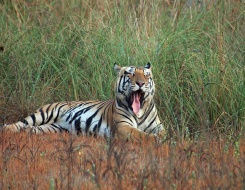Kanha National Park

Rudyard Kipling's The Jungle Book has been the reason behind the popularity of the Kanha National Park which proudly stands to be the largest national park in central India. Declared a national park in the year 1955, the park occupies the area of two districts namely Mandla and Balaghat in Madhya Pradesh.
Success of Project Tiger in multiplying the numbers of this exotic animal species has led to many efforts on the conservation of more endangered species like swamp dear. Such strategies have made the Kanha Tiger Reserve one of the best places for mobilizing system into activity to achieve greater harmony among flora, fauna and human. The forests of Banjar and Halon Valley happen to be serving as the places of shelter for the creatures of the wild.
The park has a vantage point called Bamni Dadar, also referred to as Sunset Point. From here, viewing the whole park is deemed the best even for the sighting of tigers and the prey it might be chasing at any particular time of the day. Moreover, there is a Museum inside the national park (closed on every Wed) featuring the activities of the park along with other interesting facts one might want to know of it.
Closed in the monsoon season from July to mid October, every other season is good, especially the pleasant winters, to make a visit to become a bird watcher or an animal enthusiast.
For any further information about this national park browse- https://www.kanha-national-park.com/




 Day 1 Delhi - Jabalpur
Day 1 Delhi - Jabalpur


